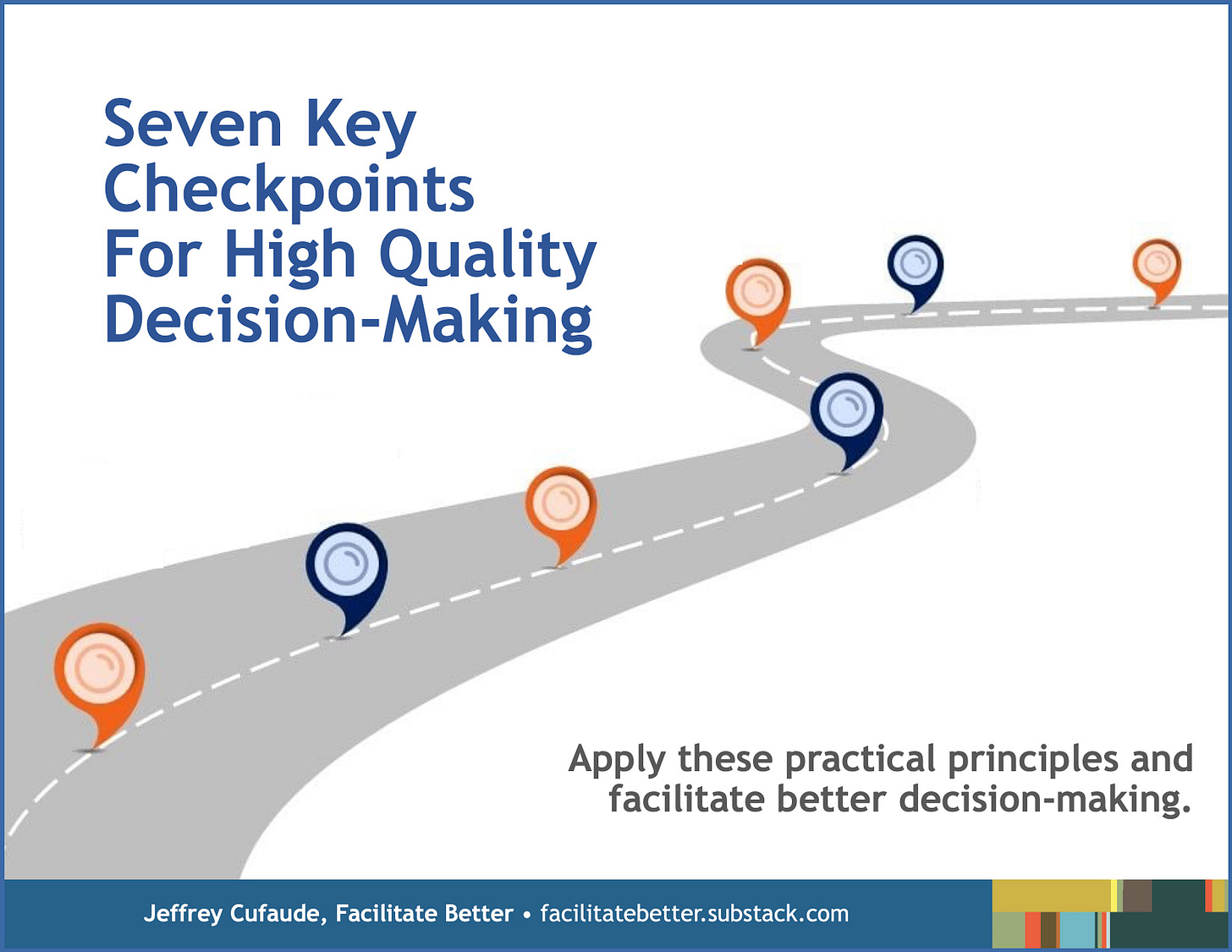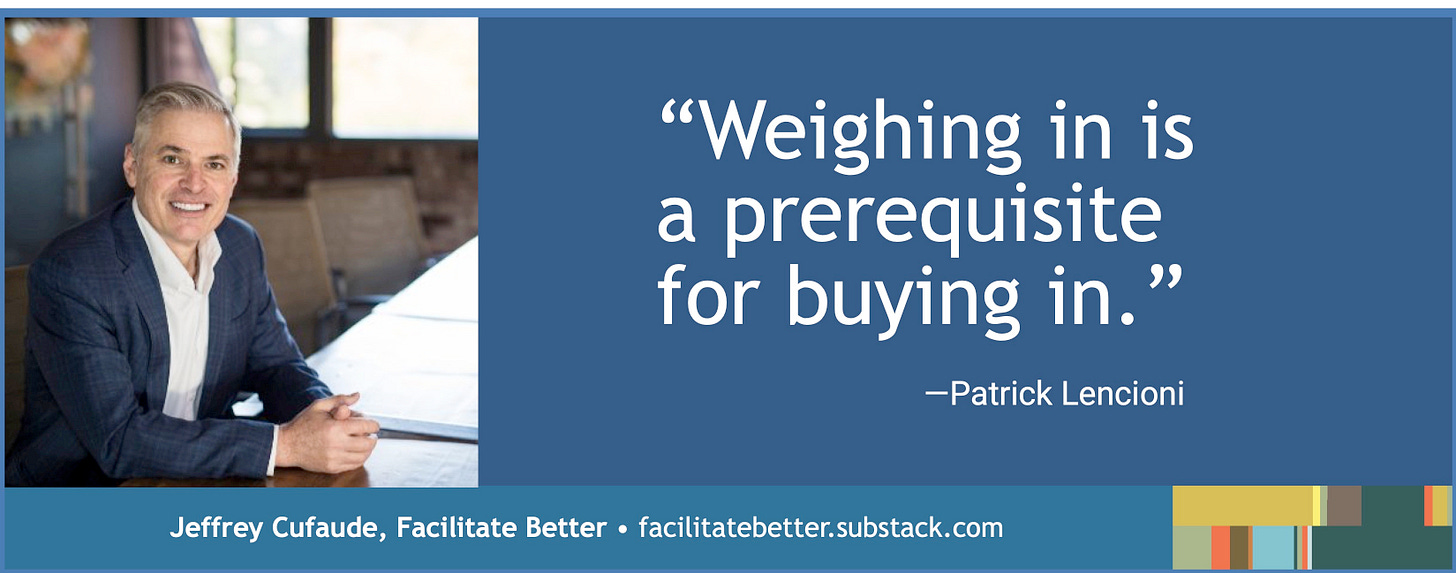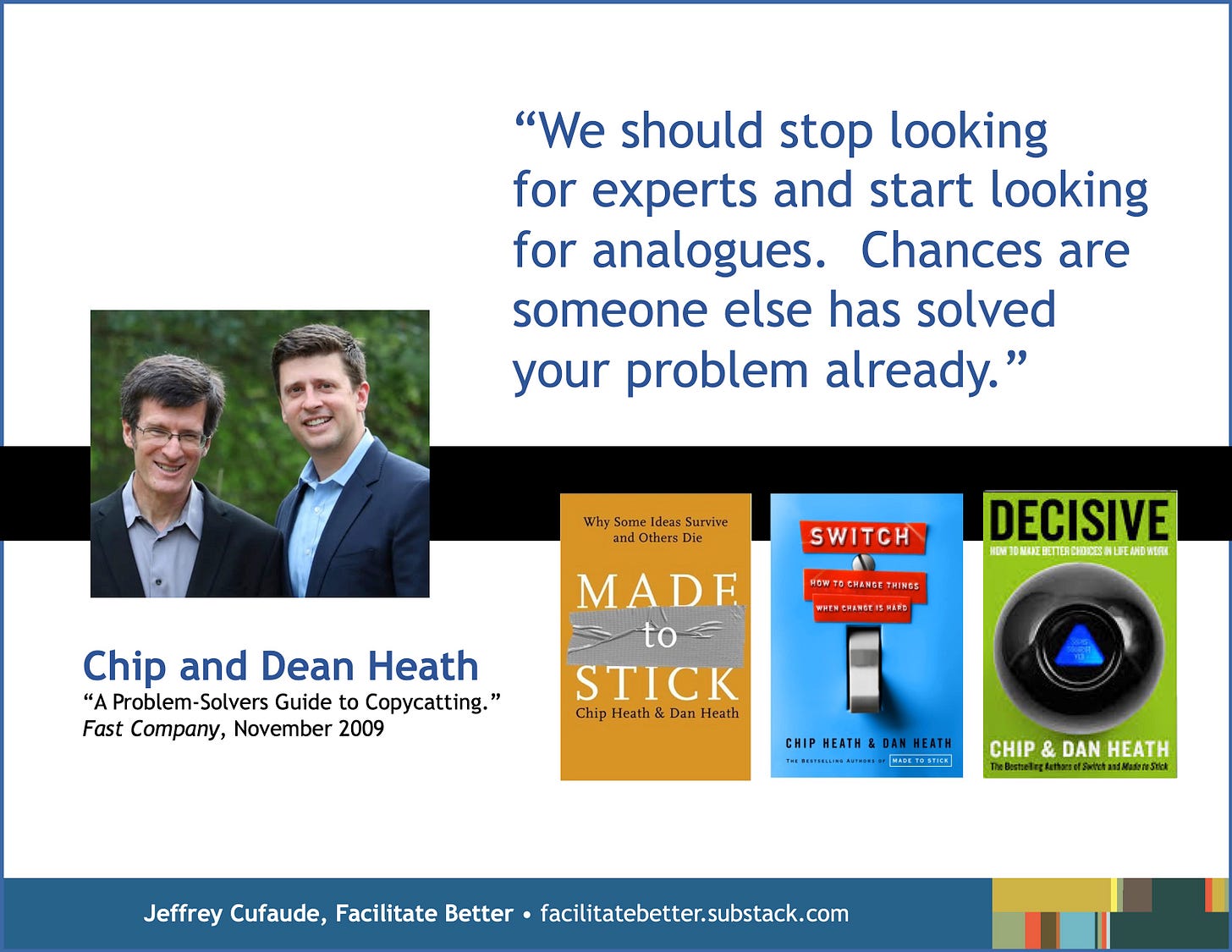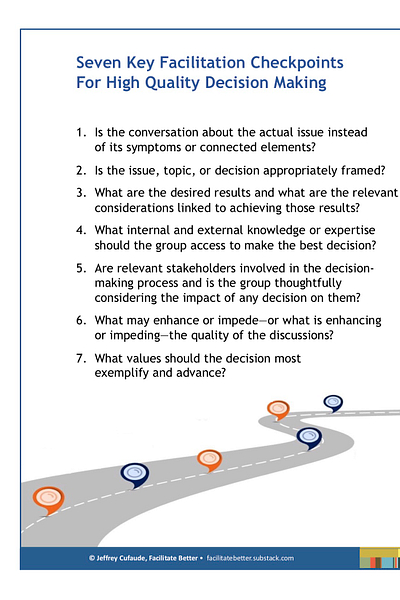Seven Key Facilitation Checkpoints for High Quality Decision-Making (Facilitation Friday #89)
The journey to high quality decisions need not be long or arduous if your facilitation efforts apply these seven checkpoints.
Participative decision-making formats like quality circles are mainstays in many organizations. Their use reflects an underlying belief that engaging a broader range of viewpoints increases the likelihood of quality discussion and quality decisions. Research backs it up.
Sometimes this belief relates most to the quality of the decision itself. Sometimes it relates most to implementation and the old adage that people support what they help to create. Or as author Patrick Lencioni has said, “Weighing in is a prerequisite for buying in.”
Managing participative decision-making, particularly when diverse individuals or organizations are involved, requires strong group process and facilitation skills. Tools like a decision-making management matrix or Edward deBono’s Six Thinking Hats can help ensure thorough consideration of alternatives an evaluation of the selected options using common criteria.
To further increase the odds of better discussions and decisions, draw on these seven checkpoints before and during your facilitation efforts.
Seven Checkpoints
1. Is the conversation about the actual issue instead of its symptoms or connected elements?
Effective facilitation ensures groups first clarify the real problem or opportunity to address. This often involves helping participants think systemically, making it easier for them to explore the patterns, processes, structures, and mental models influencing what is occurring.
2. Is the issue, topic, or decision appropriately framed?
The language used to frame what is discussed and decided is critical. Just as a frame affects how you view a picture of work of art, so does the conversational “frame” affect how participants view their options or choices.
Effective facilitation:
surfaces the underlying beliefs and the potential limits of the frames used, and
helps participants explore alternative framing to avoid unproductive discussions and groupthink.
3. What are the desired results and what are the relevant considerations linked to achieving those results?
Even when the problem or opportunity is appropriately defined and framed, groups need a shared understanding of the desired results or outcomes for the decision. I use this simple prompt to help them do so:
The ideal decision is one that …
Absent this collective understanding, those involved may advocate for options aligned with their own definitions, ones that may conflict. When definitions of success compete, thoughtful deliberations can degenerate into protecting self-interests or hidden agendas.
4. What internal or external knowledge or expertise should the group access the make the best decision?
Any group convened to make a complex, challenging, or critical decision may not have all the information and knowledge to do so. Facilitators should help them normalize looking to others to inform their discussions and decisions. Researchers and authors Chip and Dan Heath suggest these searches include analogues whose insights can be adapted for the group’s purposes rather than only turning to like organizations.
5. Are relevant stakeholders involved in the decision-making process and is the group thoughtfully considering the impact of any decision on them?
When input is not considered from those most responsible for implementing a decision and/or those it will most affect, they may subtly work to undermine any decision reached. This does not imply that every person needs direct involvement in every decision. That obviously is neither practical nor effective. The corollary, however, is equally true: failure to consult the appropriate parties places a decision’s long-term effectiveness in jeopardy.
This checkpoint also prompts consideration of the level of support that is needed for the decision’s implementation. When decisions require a more enthusiastic affirmation than consensus, groups often seek more expansive input and feedback during the decision-making process.
6. What may enhance or impede—or what is enhancing or impeding—the quality of the discussions?
Facilitators and consultants tend to have primary responsibility for group process leadership even though anyone can—and everyone should—make facilitative contributions. We understand that the quality of the decision often is tied to the quality of the discussion.
Groups need us to objectively consider what is actually happening as participants interact with each other, what’s said and what’s not said, whose thinking or contributions are not being heard or leveraged, and what interventions (questions, observations, tools, or techniques) might enhance the group’s efforts.
7. What values should the decision most exemplify and advance?
This is one of my favorite questions for decision-making processes. I rarely experience others using it, but participants often find it both clarifying and powerful. This is especially true when multiple strong options are under consideration and people are struggling to choose among them.
When made explicit, the values provide an additional criterion to evaluate options under consideration. Sharing them when a decision is announced often helps those not involved in the discussions to better understand the choice(s) made.
Bonus
Want a list with just the seven checkpoint questions to use in your own meeting design and facilitation efforts? I have you covered with the PDF below.
Bottom Line
Design and facilitation choices should always support high quality discussions and high quality decisions. This requires that topics and issues are appropriately framed, stakeholder needs and positions are thoughtfully incorporated and considered, and relevant knowledge sources are leveraged.
Getting in Action
Think of an effective decision-making session/process you facilitated or in which you participated. Consider if and how the seven checkpoints were reflected in it.
When you think of those you most facilitate, implementation of better application of which checkpoint(s) might most enhance the quality of their decision-making? How might you raise this with those individuals?
How would you modify these checkpoints based on what you associate with effective decision-making processes?
© Facilitate Better and Jeffrey Cufaude. All rights reserved.
To affordably license this content for reprint on your site or in electronic or print communications or to contact me regarding customized facilitation skills workshops or consultations, complete this form.





